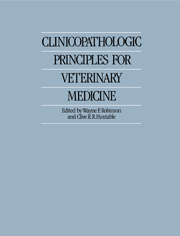Book contents
- Frontmatter
- Contents
- Contributors
- Preface
- Acknowledgements
- 1 The relationship between pathology and medicine
- 2 The immune system
- 3 The hematopoietic system
- 4 Acid–base balance
- 5 The respiratory system
- 6 The cardiovascular system
- 7 The alimentary tract
- 8 The liver and exocrine pancreas
- 9 The urinary system
- 10 The endocrine glands
- 11 The skin
- 12 The skeletal system
- 13 The nervous system
- 14 Muscle
- 15 Metabolic disease
- 16 The reproductive system
- Index
15 - Metabolic disease
Published online by Cambridge University Press: 19 January 2010
- Frontmatter
- Contents
- Contributors
- Preface
- Acknowledgements
- 1 The relationship between pathology and medicine
- 2 The immune system
- 3 The hematopoietic system
- 4 Acid–base balance
- 5 The respiratory system
- 6 The cardiovascular system
- 7 The alimentary tract
- 8 The liver and exocrine pancreas
- 9 The urinary system
- 10 The endocrine glands
- 11 The skin
- 12 The skeletal system
- 13 The nervous system
- 14 Muscle
- 15 Metabolic disease
- 16 The reproductive system
- Index
Summary
The meaning of the term metabolic disease has always been a cause for discussion. Clearly all disease is associated ultimately with changes in the rates of various biochemical pathways and so in all diseases the metabolism of the animal is abnormal to a major or minor degree. Therefore, to call any animal disorder a metabolic disease would seem a hopelessly limitless definition. However, the term metabolic disease may be used to connote a biochemical change of non-infectious origin in an animal which has been subjected to ‘apparently’ optimal husbandry. Such a biochemical change results in an increase or decrease in a metabolite critical to the function of the animal. This metabolic change is induced by an imbalance in the input or output of the metabolite or a related metabolite. Therefore it is not surprising that metabolic disease is common in lactating or pregnant farm animals, where the rate of metabolite uptake from blood to the mammary gland or fetus is high. This observation has led to metabolic diseases in farm animals being known as production diseases. The implication is that these diseases are a failure to meet an excessive output associated with the continued desire of man to increase the production of livestock.
- Type
- Chapter
- Information
- Clinicopathologic Principles for Veterinary Medicine , pp. 389 - 398Publisher: Cambridge University PressPrint publication year: 1988



